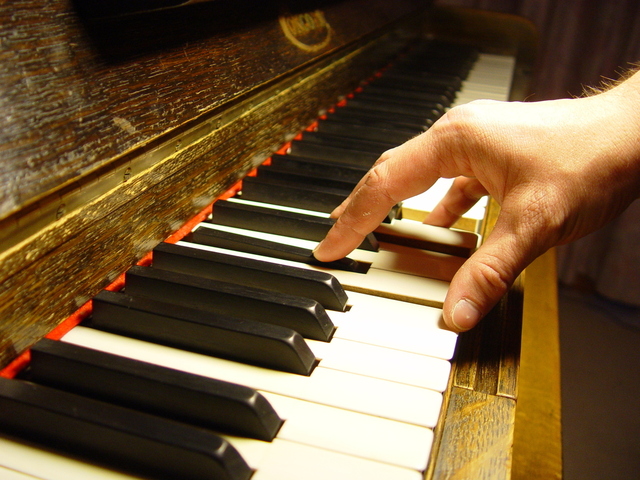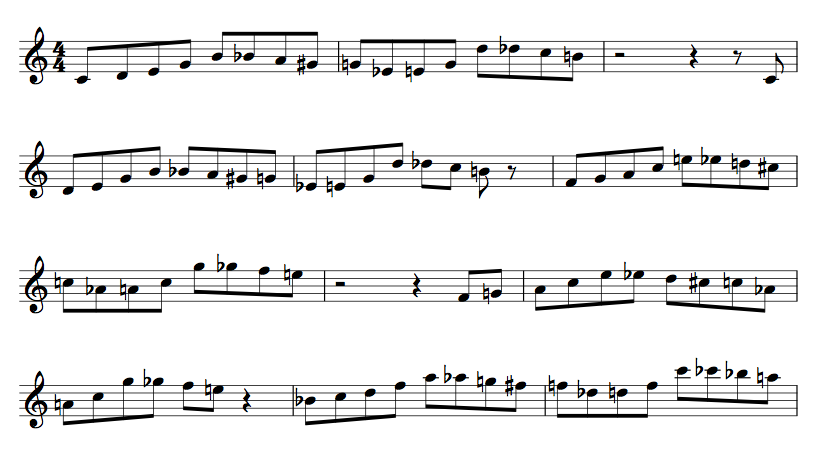One of the things that keeps many musicians from improving, is not being able to simplify complex (or difficult) pedagogical challenges. I’m talking specifically here about how these challenges are approached in the practice room.
As I improve as a musician, I notice that I also broaden my skills in breaking large (sometimes seemingly impossible) tasks into smaller, more doable parts. This has been fundamental in helping me to approach and manage technical (and other musical) issues with confidence and clarity.
In exercise science, the act of modifying a particular exercise (making it easier) to suit the limitations of the person performing it, is called regression. Just about any exercise can be regressed: less resistance (lighter weight), slower pace, movement modification, longer rest interval, greater mechanical advantage, etc. This principle of regression makes virtually any any physical activity or exercise approachable, no matter the person’s fitness level.
The same idea applies to practicing music.
Part of my job as a practice coach for musicians is to teach my clients how to regress (simplify) their challenges. This gives them a valuable tool to approach virtually any musical task.
For you to continually progress, you need to be able to meet ever increasing challenges in the practice room. And to do that, you absolutely must learn the art and science of regression. In essence, you must learn how to simplify a musical task to make it approachable for you at your current skill level.
To regress effectively, you need to be:
- Persistent-Completely committed to the task, and willing to work until you’ve mastered it.
- Patient-Putting no time constraints on yourself; allowing as many practice sessions as necessary in order to master whichever step you’re working on.
- Humble-Always accepting where you are in your abilities. You must also be willing and able to stop, reassess, simplify and redirect your efforts.
- Kind-To yourself. Keeping positive, constructive thoughts.
- Insightful-Becoming an expert on how you learn.
- Creative-Always finding new ways to break things down into smaller and simpler parts.
- Organized-Aiming your regressed efforts towards natural, logical progression (and keeping track of your work).
- Self-aware-Staying easy, relaxed, breathing, and in balance as you practice.
No matter how difficult a particular challenge may seem, your job is to break it down into pieces that are easy enough for you to handle immediately. Your aim is to give yourself a starting point, a way to get (and stay) engaged in the process of learning. Then you master each component one small step at a time.
There are endless ways to regress challenging musical tasks. Here are but a few things to think about to do so:
- Tempo-If the exercise (etude, passage, etc.) is challenging you because of tempo, find a tempo that is manageable for you. Stay with that until you’re ready and confident to move on to the next manageable tempo. Use a metronome to stay steady and track your progress.
- Rhythm-If reading a complex rhythm seems daunting, take time to do the math to figure out exactly how much value each note gets. Count it out several times. Then rewrite (or rethink) the passage in longer, but equal, rhythmic values. For example, if you’re struggling with a passage that has lots of tied sixteenth and thirty-second notes, spend some time understanding and counting (aloud) the relative value of each note, then rewrite the passage in quarter notes and eighth notes of proportionate time values. If that’s still too difficult play, write it out again in half notes and quarter notes. Once you understand the math, and feel the relative time values of each note, you’ll be surprised at how easy and simple the original rhythmic passage becomes.
- Rest-If you can’t make it through an exercise or piece in its entirety (perhaps because of endurance and/or mental focus issues), consider breaking it down into very small parts with brief (but mindfully placed) rests in between. As you develop endurance and focus, you can start eliminating the rests one at a time until you can manage the whole thing.
- Range-If an exercise or passage is just way out of your range (but still possible on your instrument), consider transposing it to a playable range (but at the extreme ends of your actual ability). Spend lots of time with it in this range (I’m talking days or weeks), then gradually modulate in half steps toward the target range, spending lots of time on each modulation until you’ve reached your goal. (Persistence is key here!)
- Information-If you feel overwhelmed with memorizing an entire piece, or are intimidated by learning a particular pattern in all twelve keys (I’m thinking of jazz musicians here), take one small segment (or one key) and really get to know it well. Play this segment to the point where you’re almost bored and truly hungry to learn more, then take another small bite, and so on. Before you know it, you’ll have it all under your fingers.
- Visualization-If an exercise, piece, task, etc., seems so intimidating that you don’t know where to start, start by thinking about it without your instrument. Learn to hear it if you can (maybe get a recording?) Vividly imagine yourself playing it as you look at the music, listen to the recording, think about the chord changes, count out the rhythms, etc. Even practice singing it. All this kind of visualization work engages you in the process of learning, and studies have shown that those who practice this way gain measurable improvements. This is often the first step in the journey that will take you to your goal.
Again, your aim should be to find a starting point, and stay engaged in the process of gaining proficiency. Ask yourself, “What would I have to do to give myself some kind of experience with this exercise (piece, etude, chord changes, pattern, etc)?” “How would I have to modify this exercise to be able to play it right now?”
No matter how small something is, it can be made smaller. Any task can be made simpler, if you use your imagination.
Anything you can do to keep yourself involved in the process (even if it’s simply visualizing or listening, or singing) is going to lead you in the right direction. Use your curiosity and passion as fuel, and you’ll improve.
Some of the most proficient musicians I know, are so (in part), because of their ability to approach challenges in this way. To them, nothing is impossible. Develop this problem solving skill, and nothing will be impossible for you, either.









